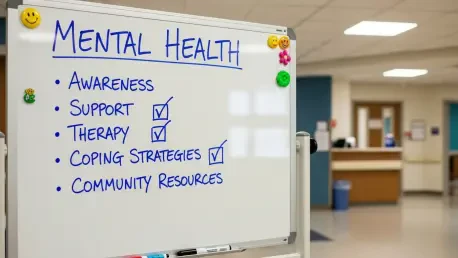Introduction to a Pressing Crisis
Imagine a young person, grappling with their identity in a world that often feels hostile, reaching out for help in a moment of despair, only to find that a lifeline specifically meant for them has vanished. This is the harsh reality for many LGBTQ+ youth following the discontinuation of the dedicated Press 3 option on the national 988 Suicide & Crisis Lifeline. The mental health crisis among this demographic has reached alarming levels, with societal stigma and policy shifts intensifying their struggles. This analysis delves into the evolving trends surrounding mental health support for LGBTQ+ youth, examining the growing need for targeted services, real-world impacts of recent changes, expert insights, and the potential future of these critical resources.
The Growing Need for Targeted Mental Health Support
Alarming Statistics and Rising Demand
The mental health challenges faced by LGBTQ+ youth are staggering, with data from The Trevor Project revealing that 39% of individuals aged 13-24 seriously consider suicide each year. For transgender and nonbinary youth, this figure climbs to nearly 50%, highlighting a disproportionate burden. These numbers underscore a critical demand for specialized support, as societal factors like stigma, family rejection, and bullying compound their vulnerability.
Since its launch, the 988 Press 3 option has facilitated nearly 1.6 million interactions, demonstrating a clear need for counselors trained in the unique experiences of this community. The spike in contacts during significant events, such as national elections, further illustrates how external stressors can exacerbate mental health crises among these young people.
Beyond individual struggles, hostile policies and public rhetoric often create an environment of fear and isolation. This systemic pressure amplifies the urgency for accessible, culturally competent care tailored to address the specific emotional and psychological needs of LGBTQ+ youth.
Real-World Impact of Service Gaps
The closure of the Press 3 option on July 17 marked a significant setback for many in crisis, as it eliminated access to counselors specifically trained to handle their concerns. Without this dedicated service, youth may hesitate to seek help from general crisis lines, fearing a lack of understanding or empathy, which can be detrimental in urgent situations.
Reports from advocacy groups have noted increased distress among LGBTQ+ youth following the discontinuation, particularly during politically charged periods like the 2024 presidential election. The absence of a tailored support line has left many feeling devalued and uncertain about where to turn during moments of acute need.
Personal accounts, though anonymized, paint a vivid picture of the impact—young individuals who once relied on this service now face heightened anxiety, unsure if their identities will be affirmed or even understood by general crisis responders. This gap in care risks deepening an already profound sense of isolation for a highly vulnerable population.
Voices from the Field: Expert and Advocate Insights
Professional Perspectives on Specialized Care
Mental health professionals and organizations, including The Trevor Project and the National Alliance on Mental Illness (NAMI), have emphasized the importance of specialized training for crisis intervention. They argue that general counselors may not be equipped to build immediate trust with LGBTQ+ callers, a critical factor in de-escalating life-threatening situations.
Advocates highlight that the loss of the Press 3 option diminishes the effectiveness of crisis support, as culturally competent care often serves as the first step in fostering long-term mental health resilience. Their warnings center on the potential for increased suicide rates if tailored resources remain unavailable to those in desperate need.
Bipartisan Concern and Federal Rationale
A rare bipartisan consensus has emerged, with lawmakers such as Representatives Mike Lawler and Young Kim urging the reinstatement of the discontinued service. Their stance reflects a shared recognition that supporting youth in crisis transcends political divides, prioritizing human lives over ideological differences.
In contrast, the federal decision to close the Press 3 option has been framed by the current administration as a matter of budgetary constraints and opposition to what some officials describe as promoting specific ideologies. Critics, however, argue that this rationale overlooks the evidence-based necessity of targeted mental health services for at-risk groups.
This clash between federal policy and expert opinion underscores a broader tension in how mental health resources are allocated, raising questions about the balance between fiscal priorities and the urgent needs of marginalized communities like LGBTQ+ youth.
Looking Ahead: Challenges and Opportunities in Mental Health Support
Future Prospects for Federal and State Initiatives
As the landscape of mental health support evolves, the potential reinstatement of federal programs like the Press 3 option remains uncertain. Some speculate that state-level innovations, such as California’s partnership with The Trevor Project to train 988 counselors, could serve as a model for sustained, localized solutions if national efforts falter.
The benefits of consistent, specialized support are clear—reduced suicide rates, improved trust in crisis systems, and a stronger safety net for vulnerable youth. However, challenges persist, including funding disparities across states and political resistance that could hinder the expansion of such programs in less progressive regions.
Broader Implications of Service Inequities
Without a unified national strategy, mental health inequities risk widening, with some areas offering robust support while others lag behind due to limited resources or restrictive policies. This patchwork approach may leave many LGBTQ+ youth without adequate care, depending on their geographic location.
Nonprofits are increasingly stepping in to bridge these gaps, but their capacity is strained without federal backing. The reliance on external organizations raises concerns about long-term sustainability and the ability to meet growing demand in the face of systemic barriers.
The ripple effects of these disparities extend beyond immediate crisis intervention, potentially shaping how future generations perceive and access mental health care. Addressing these challenges will require coordinated efforts across government, advocacy, and community levels to ensure equitable support for all.
Key Takeaways and Call to Action
Reflecting on the trends, the discontinuation of the Press 3 option stands as a critical blow to mental health support for LGBTQ+ youth, exposing the fragility of specialized services amid shifting political priorities. The alarming statistics and real-world impacts highlight the dire consequences of service gaps, while state responses showcase resilience despite uneven resources.
Expert voices and bipartisan concern amplify the urgency of restoring culturally competent care, which proves to be a life-saving measure for a population facing disproportionate risks. The challenges of funding and political opposition loom large, yet the potential for state-led innovation offers a glimmer of hope in an otherwise uncertain landscape.
Moving forward, stakeholders are encouraged to advocate for legislative measures that would reinstate or enhance accessible mental health resources tailored to LGBTQ+ youth. Supporting partnerships with nonprofits and pushing for comprehensive training for crisis responders emerge as vital steps to rebuild trust and effectiveness in mental health systems, ensuring that no young person in crisis is left without a lifeline.









